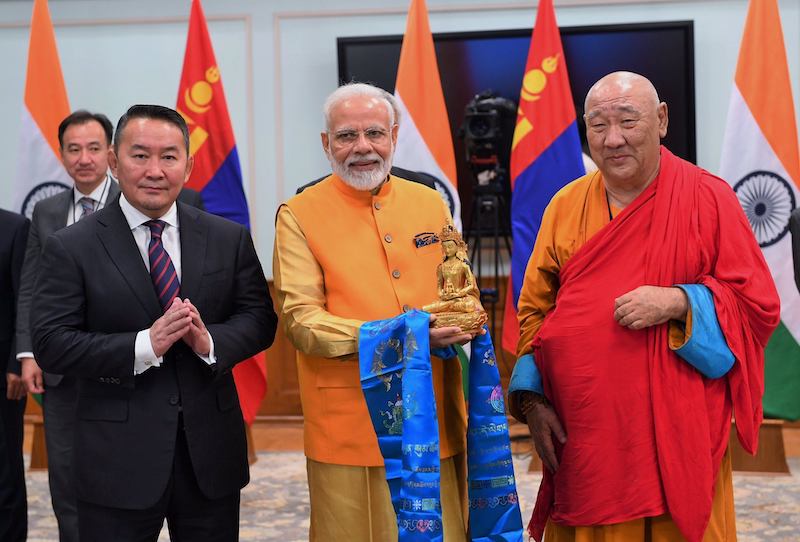It was no coincidence that just a fortnight after the third Samvad conclave from 6–7 September in Ulaanbaatar, Mongolian President Khaltmaagiin Battulga paid a state visit to India from the 19th to 23rd. This month has seen, from the perspectives of both Mongolia and India, a significant diplomatic victory over some years in the making.
Aside from meeting the Indian Prime Minister Narendra Modi and visiting places like Bodh Gaya, one of the most important milestones to emerge from this year-long bilateral engagement (including the Asian Buddhist Conference for Peace’s 50th anniversary) was a document called the Joint Statement on Strengthening the Strategic Partnership between India and Mongolia. The Indian Ministry of External Affairs released this statement on 20 September.
There are a total of thirty-five points in this bilateral document. Immediately below point 26 (an agreement to explore and exploit outer space for peaceful purposes, including remote sensing, satellite communication, resource management, weather forecasting, and disaster management) is the evident fruit of the Buddhist engagement. In total, four points are devoted to framing this new relationship:
27. President Battulga and Prime Minister Modi also jointly unveiled the statue of Lord Buddha and his disciples at the venerated Gandan Tegchenling Monastery in Ulaanbaatar noting that it would be an expression of the shared Buddhist heritage between the two countries and everlasting symbol of the spiritual union of the two peoples.
28. Both sides appreciated the successful organisation of the birth centenary of Venerable Kushok Bakula Rimpoche [sic] who played a crucial role in reviving the Buddhist linkages between the two countries. The Indian side congratulated the Mongolian side on successful organisation of the Asian Buddhist Conference for Peace and the Third Samvad Dialogue in Ulaanbaatar, underlining its role in spreading the message of peace and brotherhood.
29. Both sides noted the valuable role of Buddhism in traditional, historical relations and cooperation between the two countries and agreed to continue its further strengthening and development. Both sides also decided to commission a study tracing the civilisational connection between the two countries and to promote it worldwide.
30. The Indian side renewed its offer to the Mongolian side to provide assistance in digitisation of Buddhist manuscripts at various Mongolian institutions like the National Mongolian Library, as part of the commitment to preserve and promote the common Buddhist heritage. The Mongolian side welcomed this offer.
In May 2015, Indo-Mongolian ties had been elevated to the level of one of “strategic partnership.” Yet the Buddhist voice has lent a further upgrade of Indo-Mongolian relations. “We are not just strategic partners but also spiritual neighbors connected by our shared Buddhist heritage,” said President Ram Nath Kovind, India’s titular head of state, in a meeting on the 20th. He also noted: “Centuries-old people-to-people exchanges have been the bedrock of our ties. Buddhist monks and traders from India travelled to Mongolia with the message of peace, harmony and friendship. Similarly, over the ages, Mongolian scholars and pilgrims came to India in pursuit of Buddhist studies and spiritual blessings. This ageless tradition continues.”
This new relationship has been blessed and consecrated by Mongolia’s top-level Buddhist leaders, chief among them His Eminence Khamba Lama Gabju Demberel Choijamts. This confluence of religious and political influence is one of the most prominent examples through which Buddhism is enmeshed in the fabric of multilateral dialogue, which now spreads from as far as Bulgaria and the Czech Republic all the way to the Korean peninsula and Japan. Aside from geopolitics and our globalized economy, it is the “glocalization” (global plus localization) of ideological diffusion that can function as both stimulator and consolidator of Eurasia’s unique, multipolar presence of Buddhist values and diplomacy.
Raymond Lam is senior writer of BDG

